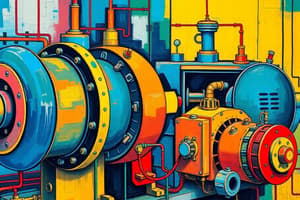Podcast
Questions and Answers
Explain the construction and working principles of a three-phase induction motor.
Explain the construction and working principles of a three-phase induction motor.
A three-phase induction motor consists of a stator with three-phase windings and a rotor with short-circuited conductors. When a three-phase supply is connected to the stator windings, a rotating magnetic field is produced, inducing currents in the rotor conductors. This interaction causes the rotor to rotate and drives the mechanical load. The working principle is based on the induction of currents in the rotor due to the rotating magnetic field.
What are the types of DC motors and what are their characteristics in terms of speed, torque, and torque-speed?
What are the types of DC motors and what are their characteristics in terms of speed, torque, and torque-speed?
The types of DC motors include series-wound, shunt-wound, and compound-wound motors. Series-wound motors have high starting torque and variable speed, shunt-wound motors have relatively constant speed, and compound-wound motors have a combination of series and shunt characteristics. The speed of a DC motor is inversely proportional to the flux, while the torque is proportional to the armature current. The torque-speed characteristics of a DC motor show that the speed is inversely proportional to the torque.
Explain the significance of back EMF in DC motors and provide the EMF equation for a DC motor.
Explain the significance of back EMF in DC motors and provide the EMF equation for a DC motor.
The back electromotive force (EMF) in a DC motor is the voltage induced in the armature winding due to the rotation of the armature in the magnetic field. It opposes the applied voltage and limits the armature current, thereby controlling the motor speed. The EMF equation for a DC motor is given by $E = P\phi ZN/60A$, where $E$ is the induced EMF, $P$ is the number of poles, $\phi$ is the flux per pole in webers, $Z$ is the total number of armature conductors, $N$ is the speed in rpm, and $A$ is the number of parallel paths in the armature winding.
What is Faraday’s law of electromagnetic induction and how does it relate to the production of electromotive force (EMF)?
What is Faraday’s law of electromagnetic induction and how does it relate to the production of electromotive force (EMF)?
What is the basic principle used in machines for energy conversion and how are the variables potential, current, torque, and speed related in the context of power conversion?
What is the basic principle used in machines for energy conversion and how are the variables potential, current, torque, and speed related in the context of power conversion?




